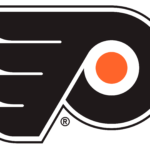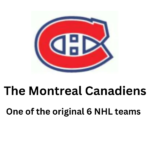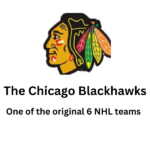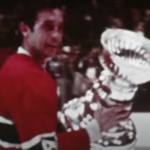The National Hockey League (NHL) is home to some of the most unique, lovable, and iconic mascots in all of professional sports. You’ll get to know all of the NHL mascots from the San Jose Shark’s “Sharkie” to the Calgary Flames “Harvey The Hound,” and everything in between. Each team has a fuzzy character that embodies their spirit and provides an additional level of entertainment for fans. Here’s a closer look at the mascots for all NHL teams in alphabetical order.
The Mascot For The Anaheim Ducks
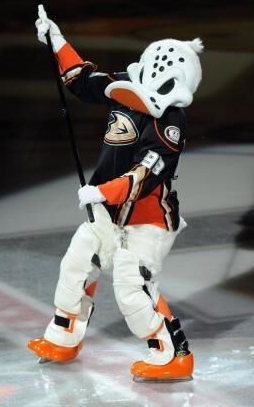
Ducks Wild Wing Mascot: A Representation of Fun Sports Culture
The Ducks Wild Wing mascot is a lively and fun representation of the sports culture of the Anaheim Ducks. The mascot made its first appearance in the mid-1990s when the team was created. It is both a reflection of the joy of hockey and a tribute to the team’s loyal supporters. The Ducks Wild Wing mascot is a symbol of the enthusiasm, determination and passion that goes along with being an Anaheim Ducks fan.
The Anaheim Ducks mascot is modeled after the legendary Anaheim Wild Wing hockey team. The Wild Wing was a minor league hockey team that was founded in 1993 and played until 1996. They played their home games in the now defunct Long Beach Arena in California. The team dissolved in 1996 and its logo and mascot was passed on to the Anaheim Ducks. While the original Wild Wing logo was redesigned and updated to better suit the Anaheim Ducks, the mascot was kept true to its roots.
The Ducks Wild Wing mascot is a lively character that is usually seen wearing a Ducks Wild Wing jersey and a hockey helmet. The mascot also carries a hockey stick and wears sneakers with text that read “Go Ducks!”. The mascot often interacts with the audience, letting them know how much they appreciate the Ducks fans and their continued support. The mascot also cheers on the Anaheim Ducks when they score a goal and leads fans in cheers to get the crowd going.
The Ducks Wild Wing mascot is a fun and friendly representation of the Anaheim Ducks hockey team. It is a symbol of the storewide enthusiasm and determination that goes with being a Ducks fan and participates in many of the team’s charitable projects and fundraisers. The mascot also represents the wild and energetic spirit that goes along with supporting a hockey team and attending hockey games. The Ducks Wild Wing mascot is a perfect representation of the loyalty, joy and passion that goes along with being an Anaheim Ducks fan.
The Arizona Coyotes Mascot
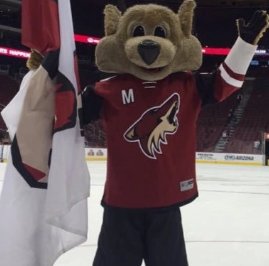
The Arizona Coyotes mascot goes by “Howler” and was first unveiled in 2003. Howler is a coyote dressed in a jersey and hockey equipment, ready to take the ice. He is an anthropomorphic mascot, which means he is a human-like character that emphasizes certain traits, which in this case is the fierce agility and strength of a coyote.
Howler is a sign of celebration for fans of the Arizona Coyotes and is seen at many events around the arena. He greets fans at the entrance and acts as the energetic spirit of the team. Howler also openly celebrates goals with the fans, dancing and leading cheers. He appears in promotional events and merchandise to be the face of the team, that can be bought in the form of shirts, keychains, and plush toys.
The Arizona Coyotes owe a lot to Howler as he has become a kind of mascot culture ambassador. Whenever he shows up, he gets the attention of kids and helps him to bond with the team and the game, even outside the rink. Howler has been sponsored by the Arizona Coyotes many times, appearing on seats and pillows. He has even been seen at other events such as conventions, golf tournaments, and college events.
Howler is more than a mascot for the Arizona Coyotes, he is also a symbol of all ice hockey teams that play in Arizona. The mascot, described as having grey fur and yellow eyes, has two brothers named “Howley” and “Sly”, which help to make the mascot family complete. While Howler may not be as recognizable as other mascots such as Gritty of the Philadelphia Flyers, Usain Bolt of the Los Angeles Clippers, or Clutch of the Houston Rockets, he is still an important part of Arizona’s hockey culture.
The Arizona Coyotes have their mascot to thank for helping the team make lasting memories, promoting the Coyotes brand, and staying loyal to the team. He certainly is an amazing addition to the Coyotes and will continue to help them make history in the NHL.
The Boston Bruins Mascot
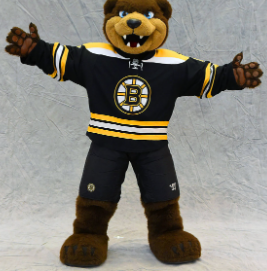
The Boston Bruins mascot has been bringing joy and laughter to Bruins games since the 1995-1996 season. His name is Blades, and he has a deep history with the organization and the city of Boston.
Blades the Bruin’s mascot is a huge brown bear that wears a black and gold Bruins’ jersey with the number 00. He has long shaggy black fur, and his eyes are bright blue. He also wears a black and yellow Bruins’ baseball cap with a big “B” on it. Blades loves to show off his moves on the ice, and he loves to interact with the fans. He loves to lead the fans in chants, and he’ll even high five them when they make a good shot.
Blades was created by the marketing team of the Bruins and was approved by the franchise. He was originally designed as an official mascot for the NHL, but he eventually ended up residing exclusively in Boston. The Bruins organization was looking for a way to give the franchise a boost and Blades provided the perfect way to do it.
Blades was named after the legendary Bruins’ defenceman, Eddie Shore. Shore was known as the “Bruin’s Iron Man” for playing every game for nine consecutive years and for being one of the toughest and most beloved players on the team. The Boston Bruins were inspired by Shore’s toughness and chose to name the mascot after him in honor of his contributions to the team.
Blades has been recognized nationally and internationally for his contribution to the Bruins. In 1998, Blades was invited to the NHL Awards Ceremony in Toronto, where he was presented with an award for mascot excellence. Blades has also been featured in numerous television commercials, print ads, and radio spots. Blades has had several different costumes over the years, but he still maintains his original design and look.
Blades continues to be a beloved mascot to Bruins fans around the world. He brings a sense of fun and excitement to every game, and he continues to delight fans with his signature dance moves. Blades is truly an icon of the Bruins organization, and he will continue to bring joy to the fans of Boston for many years to come.
The Buffalo Sabres Mascot
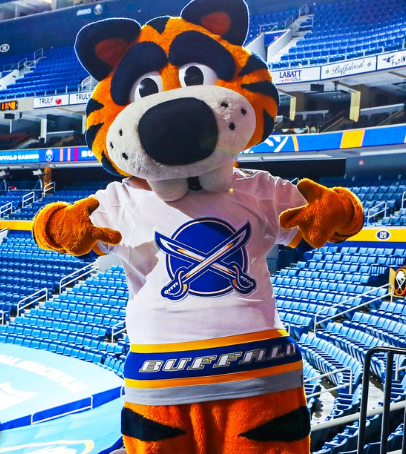
The Buffalo Sabres, based in Buffalo, NY, are the NHL’s original expansion club. They were the first of the twelve franchises to join the league in its expansion from six to 12 teams in 1970. The Sabres have a rich history, beginning with their inception and extending through the eras of such iconic players as Gilbert Perreault and Dominik Hasek.
A key part of the Sabres’ history is their official mascot, Sabretooth. The Sabres debuted Sabretooth in 2000 and he has become a beloved part of the Buffalo community. Sabretooth, who is a saber-toothed tiger, is closely modeled after the team’s namesake animal. He wears the team’s official colors, black, red and white, and is a familiar sight at games, fan events and community programs.
Sabretooth is best known for his larger-than-life antics and boisterous personality. He is a true leader on the ice, charging onto the ice and encouraging the crowd to cheer along with him. Sabretooth is incredibly active throughout the game, often leading cheers for the Sabres and energizing the crowd. When the team scores a goal, he does a few of his signature moves, including a somersault and a spin.
Off the ice, Sabretooth loves to get involved in the community and make special appearances at events throughout the city. He is a regular at all sorts of events, from youth hockey games to charitable causes. As a goodwill ambassador for the Sabres and Buffalo, Sabretooth also attends schools, festivals and parades all over New York State. He is not just fun and games, though—he also carries a powerful message of character, courage and community.
In short, the Buffalo Sabres have an amazing mascot in Sabretooth the Saber-Toothed Tiger. He is the epitome of passion and spirit who proudly represents the team no matter the setting. Surely, their fans, young and old, take tremendous delight in Sabretooth and the unique experience he brings to every game and event he attends.
The Calgary Flames Mascot

The Calgary Flames’ mascot is an anthropomorphized tongue-wagging dalmatian named Harvey the Hound. This furry character has been an integral part of the Calgary Flames since 1984. He is one of the most recognizable mascots in the National Hockey League and is an essential part of the game experience for fans in attendance.
Harvey is a live mascot who attends games at different venues throughout the season, including when the Flames are on the road. He is always dressed in a Flames jersey and signature Flames hat, showing his commitment to the team. He is always eager to show his support for the team and is a beacon of encouragement for the crowd.
When at games, Harvey is known for his unique interactions with both players and fans utilizing his tongue which is able to snag loose pucks. If a visiting player breaks the rules and interrupts the game, it is not unusual for Harvey to formulate a response by hopping around the rink in true mascot fashion. He also loves to create random “harvestivities” in order to liven up the environment and leave fans in stitches.
Apart from the usual game-night antics, Harvey has a variety of other projects which he is associated with. For example, in 2012 he launched “Harvey and Friends”, a charity that supports a variety of organizations including The Flames Foundation, Ronald McDonald House, Special Olympics and Camp Quality. Harvey’s fun-loving personality has allowed him to gain friendships with many notable figures including Governor General David Johnston and Prime Minister Justin Trudeau. He has even made cameo appearances on the popular television show, Modern Family.
Aside from his character, the fact that the Flames have had the same mascot for over 30 years speaks volumes. Throughout his career, Harvey has been an ambassador for the team, an inspiration for its fans and an integral part of the Flames’ experience. Although Harvey may have changed a bit over the years, his spirit and enthusiasm remain the same and will likely remain steadfast for the years to come.
The Carolina Hurricanes Mascot
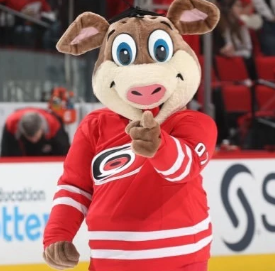
The Carolina Hurricanes are a professional ice hockey team in the National Hockey League (NHL). The team, based in Raleigh, North Carolina, was originally founded in 1972 as the New England Whalers, and is now the oldest professional sports franchise in North Carolina. For the 2019-2020 season, the Hurricanes have attained the playoffs. As part of the organization’s identity, they have an official mascot, Stormy the Icehog, who is often seen galivanting around and cheering on the crowd at games.
For an NHL team mascot, Stormy has a unique look. He is a humanoid-looking creature made of ice, with a small black beard, a large eye patch, and a tail ending in a tuft of smoke. He wears a red, orange, and black sweatshirt with the Hurricanes logo, as well as ice skates. His appearance is meant to symbolize the dynamic nature of the team, as well as its maverick ability to bring a lot of energy and enthusiasm to the game. Born in 2002, Stormy is the official mascot for all Hurricanes home games and public appearances.
Stormy’s job is to bring excitement and spirit to the game. For example, during intermissions and other interludes during the game, he can be seen entertaining the crowd with various antics, such as dancing, comedy skits, and crowd engagement games. He also help promote spirit and excitement among Hurricanes fans, by getting them hyped up for the team and for certain game plays.
In terms of charity and outreach involvement, Stormy acts as a direct representative of the organization. He often attends event gatherings, charity drives, and parades in order to bring a smile to those around him, while also inspiring others to cheer on the Hurricanes.
Aside from skating around the ice, Stormy also is the official cheering partner of the Hurricanes Energy Team. This particular group of loyal Hurricanes fans makes their presence felt at every game with their unwavering support and enthusiasm for their beloved team. Stormy is often seen at these games alongside the Energy Team, leading chants and performing various cheer moves designed to bring unity and energy to the fans and the rest of the game.
The Carolina Hurricanes mascot, Stormy the Icehog, is a beloved member of the organization and its ongoing success. He entertains fans and adds spirit to games, while also acting as a direct representative of the team through charity and outreach activities. His unique ice-made figure, along with his fun-loving attitude, symbolize the team’s maverick spirit, while also bringing unity and energy to all Hurricanes games.
The Chicago Blackhawks Mascot
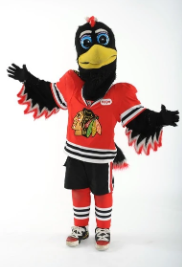
The Chicago Blackhawks have long been a symbol of the city of Chicago and its inhabitants, but recently they have taken a bold new step in unifying the team and its fan base with the introduction of a black hawk mascot. The Chicago Blackhawks mascot, originally named “Tommy Hawk” when he debuted in 1994, recently received a makeover and was renamed “Billy the Hawk”. This symbol of the team is meant to be the physical embodiment of the Chicago Blackhawks, representing both the team and the city.
Billy the Hawk is an eight-foot tall bird, complete with a black and red head and stripes, who wears a replica of the team’s jersey. He is designed as an approachable and lovable character meant to bring fans into the game. He is always rocking a smile and entertaining fans with his enthusiasm for the game and his impressive acrobatics. He has a broad range of activities, from slam dunking and t-shirt tossing during games, to hosting special events, performing meet and greets, appearing in commercials and making countless public appearances.
Billy’s design was the the result of a collaboration between the Chicago Blackhawks and V Star Entertainment Group, and is a reflection of the team’s effort to reach out to all members of the Blackhawks family. Billy’s unique design is a combination of inspiration from the iconic players to the team itself, while maintaining the spirit and passion of the Chicago Blackhawks.
The Chicago Blackhawks have further updated their look with the addition of a new “BlackHawk”. His uniform remains the original black and red of the team but his helmet has the turtle shell profile of a hawk, complete with a red eye. BlackHawk was designed to a recognition symbol for fans to connect with the team, and his presence in the stadium serves to unify the team and its fan base. He also helps coordinate special events for the team and fans.
With the introduction of a newly modified mascot and a new look, the Chicago Blackhawks look more unified than ever. It is a testament to the team’s commitment to expanding its reach and connecting with fans in meaningful ways. With the ongoing support of Billy the Hawk, the Chicago Blackhawks have made the game of hockey more accessible and interactive than ever before.
The Colorado Avalanche Mascot
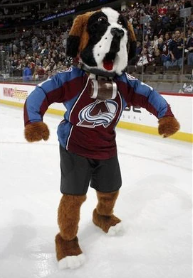
The Colorado Avalanche are an NHL team that is known for their incredible team spirit and mascot, Bernie. Bernie, or “Bernie the St Bernard”, is an iconic figure for the team and has been around since the team’s beginning in 1995. This lovable mascot is a cuddly and faithful companion who loves to cheer the Colorado Avalanche on.
Bernie the St Bernard first came to be on a snowy December evening in 1995. As the team was preparing for their first home game in Denver, they wanted to find a mascot that would embody the spirit they wanted to bring to the rink. As they scoured the area for ideas, they stumbled upon Bernie, who was being rescued in the snow. His unique warmth and loyalty was a perfect fit for the team, and they decided to make him their mascot.
Since then, Bernie has been an essential part of the Colorado Avalanche. He has been on the ice during all regular season games, and has been known to entertain the crowd with his unique dance moves and charm. Bernie has also been known to accompany players to various team events, including parades and fundraisers. His playfulness and affection for the team is unparalleled, making him a true fan favorite.
When he is off the ice Bernie still shows his loyalty to the Colorado Avalanche in a variety of capacities. His favorite pastime is chatting and taking pictures with fans, as well as participating in post-game meet-and-greets. He is also an enthusiastic volunteer for local charities, and is a regular fixture at the organization’s annual events.
Bernie is a beloved figure and an integral part of the Colorado Avalanche family. He is a lovable, cuddly mascot that is always ready to cheer on the team and show his support. His unique spirit and loyalty is an example to all who cheer for the Colorado Avalanche.
Columbus Blue Jackets Mascot
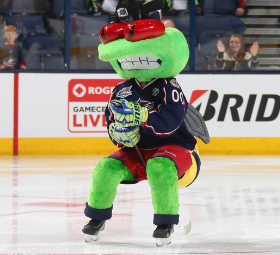
It’s impossible to think about the Columbus Blue Jackets without also thinking about their mascot—the slim, 7-foot-tall, fuzzy, bug-eyed, ever-grinning figure known lovingly to fans as Stinger. Since the team’s inception in 2000, Stinger has served as the unofficial face of the Blue Jackets, interacting with fans and entertaining viewers with his enthusiasm during intermission segments, sponsored events, and more. But what exactly is Stinger, and where did he come from?
Officially, Stinger is described as a “superhero wildcat,” making him part of the same species as cats, tigers, leopards, and more. However, despite his wildcat roots, Stinger resembles more closely a bee than any other creature. Stinger wears a large blue helmet adorned with a bee-like crest and a pair of large antennae that stick out from his head, and his unique outfit includes shirt and shorts combinations with yellow polka dots and large, fuzzy brown arm and leg warmers.
Stinger has long been associated with the Blue Jackets, yet his roots can be traced to a previous team: the AHL’s Syracuse Crunch. It was this minor league squad—then called the Crunch, now an affiliate of the Blue Jackets—who introduced the first version of Stinger in 1995, where he appeared as an orange wildcat in an orange and black outfit. This design changed drastically in 2000 as the Blue Jackets adopted Stinger as their mascot.
More than just a fun and furry mascot, Stinger serves to energize and excite fans with his presence. A good luck charm of sorts, Stinger can be seen rallying the crowd, wearing a racoon cap, waving a light saber above his head, fist-bumping with the Blue Jackets’ bench, and much more. Stinger’s versatile, fun-loving personality and ability to engage with fans of all ages have made him one of the most beloved mascots in professional sports today.
Stinger may look a bit silly and may not have the history some other mascots possess, but his value to the Blue Jackets organization cannot be overlooked. It is through Stinger’s charisma and energy that the Blue Jackets have created a team identity and cultivated meaningful relationships with fans. The Columbus Blue Jackets may be a relatively young franchise, but with Stinger, they’re sure to make their mark in professional sports for years to come.
The Dallas Stars Mascot
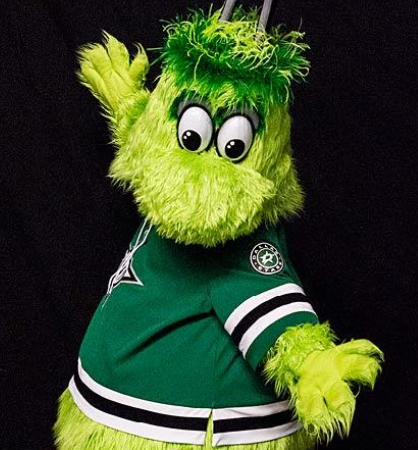
The Dallas Stars mascot is a lovable, huggable, green hockey-playing dragon named “Victor E. Green”. Victor has been the official mascot of the National Hockey League’s Dallas Stars since 2004, and he has been entertaining fans both young and old for 16 years.
Victor was the brainchild of the organization, who wanted to create a unique logo and mascot to represent its team. He was an instant hit with the fans due to his eye-catching looks and fun personality. Victor wears a traditional hockey uniform on the ice, complete with a Stars jersey, pants, pads and a shiny gold helmet. It’s said that Victor loves to play keep-away with pucks, along with his occasional mimicking of penalty shots.
Victor’s mission is to entertain the fans of the Dallas Stars and encourage hockey fans young and old to join the fun. His high energy level, comedic actions and friendly manner have made him a fan favorite throughout his tenure in the NHL.
Victor’s official backstory states that he was originally a playful baby dragon who grew to be the largest dragon in Texas. He was always excited to play pickup hockey and eventually ended up playing in a frozen pond outside the American Airlines Center (home of the Dallas Stars). He became such a fixture that when the Stars moved to Dallas, he moved with them to be their official mascot.
His other hobbies include playing video games with friends, tailgating at Dallas Stars games, eating chips and salsa, and often showing off his “over-the-top” dance moves.
In addition to his duties as the Dallas Stars mascot, Victor E. Green also enjoys getting involved with the community. He can often be seen at various schools and charities promoting the Stars and getting kids excited about the game of hockey. He’s also a big supporter of the Hockey Fights Cancer initiative, making surprise visits to hospitals across the country to spread cheer.
Without Victor E. Green, the Dallas Stars would not be nearly as exciting and entertaining. Whether he’s entertaining fans in the stands, entertaining kids in the community, or showing off his dance moves, Victor is truly an amazing mascot and a great ambassador for the Dallas Stars.
The Detroit Red Wings Mascot
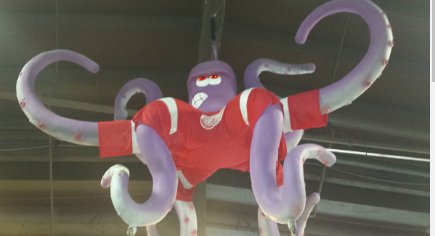
The Detroit Red Wings have a rich history of mascots, with the most beloved being an eight-limbed octopus. The history of the mascot dates back to the 1950s, when it was first introduced as a way to celebrate the team’s success and show the fans their appreciation. The mascot has since become part of the Detroit Red Wings culture and iconography and has been present at every home game since.
The octopus was first introduced to celebrate the team’s successful quest for the Stanley Cup in 1952. The Red Wings had not won the championship since the 1930s, so when they achieved the feat, a fan tossed an octopus onto the ice in celebration. The eight legs of the octopus were meant to symbolize the eight wins needed to take home the Stanley Cup. The group of octopi that climbed down from the stands quickly became associated with the team and the Detroit Red Wings mascot was born.
The octopus mascot not only represents the Red Wings’ goal of winning, but also their strength and resilience. The Red Wings have been able to pull through and reach the Stanley Cup time and time again, despite many struggles and losses. This makes the octopus the perfect mascot and a symbol of inspiration for the team and their fans.
The octopus mascot is typically seen on the ice during home games in Detroit, as well as at away games when the Red Wings are playing in other cities. It is often seen on the jumbotron, performing a variety of antics to entertain the crowd. While other teams bring out a human mascot, the Detroit Red Wings mascot is consistently an octopus.
The octopus mascot has become an iconic symbol of the Red Wings and is often used in the team’s merchandise. It is portrayed in various forms and colors, from the classic red and white, to green and yellow, and each version has its own special meaning.
The Detroit Red Wings octopus mascot represents the team’s hard work and determination. It is a symbol of the team’s resilience, strength, and appreciation for their fans. For nearly 70 years, it has been seen at home games in Detroit, and its image has been used to promote the team across the world.
The Edmonton Oilers Mascot

Since the very inception of the Edmonton Oilers, the megalopolis of Edmonton, in Alberta, Canada, has adopted the team’s mascot as part of its identity. The Oilers mascot serves to represent the team’s values, spirit, and drive, while embodying the city’s contagious passion.
The Edmonton Oilers mascot is Hunter, a 6-foot tall anthropomorphic inner tube that wears an Edmonton Oilers uniform and is equipped with a custom-made net that can open and close for slap shots and blocking shots, as well as a pair of skates and a helmet. Hunter is colored in charcoal and orange, the official colors of the Edmonton Oilers. He is always in high spirits and brings energy to the arena with high-fiving, dancing, and a comical and contagious enthusiasm.
Hunter was born at a charity hockey game in 2003, when then-Oilers player Ethan Moreau unveiled the newly created mascot, to much fanfare and appreciation. Hunter’s friendly and rambunctious personality quickly won Edmontonians over, and he quickly attained cult-like status, becoming a true Edmontonian icon. Nowadays, Hunter is a regular fixture at all Oilers home games, and he is known to often intermix with the crowd, entertaining the attendees and making them feel included and part of the team’s journey.
Along with his appearances at Oilers games, Hunter also makes frequent public appearances at local schools and hospitals to bring a smile to children’s faces and impact the lives of those less fortunate. Hunter is something of a beacon of hope in Edmonton and has helped create a sense of unity and identity in the region.
Each year, through Hunter’s “Hunter Helps” program, a portion of the proceeds from Oilers games are donated to charity organizations within Edmonton and the surrounding communities. Additionally, Hunter makes regular school visits to promote good nutrition, wellness, and physical activity.
In short, the Edmonton Oilers mascot Hunter is an integral part of the city’s sports culture. He embodies Edmonton’s enthusiasm for hockey and has captured the hearts of citizens everywhere, serving as a source of inspiration, encouragement, and hope. Through his playful and friendly demeanor, Hunter has positively impacted the city and beyond, and he will no doubt be an integral part of Edmonton’s identity for many years to come.
Florida Panthers Mascot
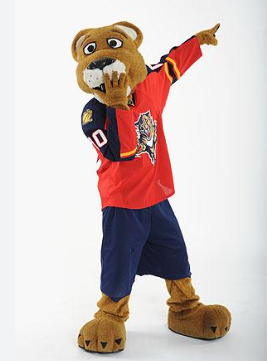
Anthropomorphic Florida Panthers mascots have been part of Florida’s hockey culture since the inception of the team in 1993. The Florida Panthers, commonly referred to by locals as the NHL’s “Cats,” are a National Hockey League (NHL) team based in Sunrise, Florida and they play at the BB&T Center. Since the beginning, their mascot has been modeled after the team’s name, representing their identity and spirit celebration of hockey in the sunshine state.
The Florida Panthers mascot is called Stanley C. Panther, and he is loved by fans throughout the state of Florida and beyond. Stanley is clad in a traditional Panthers jersey and black hockey skates, and he rocks a flame-red head with a black mane and goatee. He also proudly wears a Panthers patch on his shoulder. Stanley is certainly the ultimate Florida Panthers fan, and helps to rally the team, the players, and the fans in a unique and unforgettable display of spirit.
Stanley C. Panther has been deemed one of the most expensive mascots in the NHL, costing upwards of $5,000 to design and create. Stanley was created by South Florida-based design and fabrication firm Image Engineering, a heavily involved crew of artists, sculptors, costumers and animatronic experts who specialize in mascots, corporate image development, special effects, and theme park attractions. His design represents one of the most sophisticated and lifelike mascots in the league, and its interactive nature is one of the many attractive features.
In addition to his mascot-like looks, Stanley C. Panther is equipped with numerous interactive features. He is able to flip his head over and around, while also moving his arms and tail synchronously. Not to mention, he can strike a mean ice-skating pose, as well as dance and walk around while skating. Furthermore, he is also able to connect with fans on social media via several accounts, including on Instagram, Twitter, and Faceboook.
The appearance of Stanley C. Panther is something that all hockey fans recognize. His unique and interactive nature, along with his spirited behavior, have been a staple in the fandom culture of Florida hockey since 1993. His presence adds to the electric atmosphere inside the BB&T Center, proof that having the right mascot can make all the difference in any sports environment.
The Los Angeles Kings Mascot
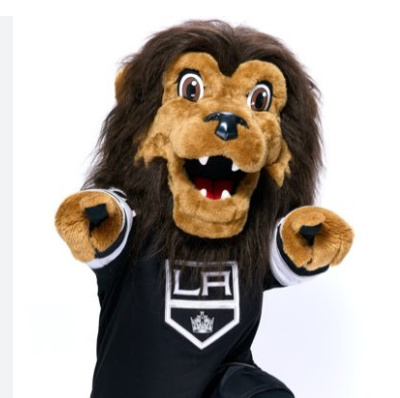
The Los Angeles Kings mascot is one of the most iconic symbols of the well-known professional hockey team. Named “Bailey”, the Kings mascot is a lovable and friendly lion that loves to get the crowd excited during Kings game days. Since being created in 2007, Bailey has become an integral part of the team’s experience and identity.
Bailey is a gigantic lion, standing 7 feet tall and weighing in at 150 lbs. He has golden fur with black highlights, a black mane and blue eyes. His face is friendly and approachable and he wears a crown on his head to signify his status as king of the rink. He also sports a blue Los Angeles Kings jersey with the word “Bailey” stitched in white on the back. Despite his intimidating size and impressive mane, Bailey loves to get involved with the crowd and stands for what the Kings stand for: strength, courage, loyalty and sportsmanship.
During a Kings game, Bailey can be found entertaining fans of all ages with his fun and exciting antics. He loves to take part in the famous “Kiss Cam” and often surprise fans with special treats and gifts, such as plumes of fake snow so that they can join in on the Kings winter shenanigans. On the ice, Bailey can be seen showing off his impressive moves to the rhythm of some of the best hockey songs and can even be found leading the crowd in a chant or two.
Off the ice and away from the event, Bailey serves as a source of good cheer and comradery. Through his various charity and volunteer efforts and school programs, he works to bring together the entire Kings community in a safe and positive manner.
From the roar of the crowd in the stadium, to the smiling faces of the children in the hospital, Bailey is the perfect symbol of what it truly means to be a Los Angeles King. His friendly demeanor and dedication to his work make him an invaluable part of the Kings organization and have made him the mascot that the Kings and their fans around the world have come to love.
The Minnesota Wild Mascot
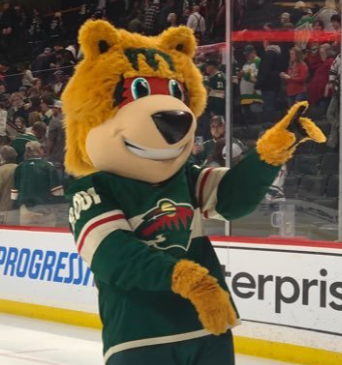
In the world of professional hockey, there are few mascots as popular as those of the Minnesota Wild hockey team of the National Hockey League. The Minnesota Wild mascot goes by the name of Nordy, and he takes the form of a naturalistic-looking wild animal that evokes a sense of the outdoor spirit of Minnesota and the surrounding areas.
Since its introduction in 2000 as the team’s official mascot, Nordy has been a popular sight throughout Minnesota Wild hockey games, events, and other team related activities. As a wild wolf, the mascot emphasizes the teams’ tenacity and dedication to their fans and the game.
Nordy’s appearances have been a hit among fans young and old. Before games, fans of all ages can be seen taking pictures with the mascot and having a great time. During games, they can spot Nordy out on the ice, skating around and waving to fans. Nordy often hands out t-shirts and other goodies to fans during stoppages of play and sometimes participates in audience-participation activities. These activities often help to rile up the crowd and get everyone into the game.
Nordy represents the spirit of Minnesota, and he is proud to call the Xcel Energy center home. He makes regular appearances across Minnesota, representing the Wild at events and gatherings. Nordy particularly loves to make appearances at schools, charities, and community gatherings in and around the Twin Cities. He has also become Monday’s embrace team mascot and is proud to represent Minnesota hockey fans everywhere.
Indeed, Nordy has become an important part of the team for fans and players alike. Even the players love it when Nordy comes out to cheer them on during the game. Not only does Nordy bring a sense of excitement and fan engagement to the game, but he also serves as an important symbol of the team’s pride and identity.
For all these reasons, Nordy is often referred to as the heart and soul of the Minnesota Wild and a beloved figure among hockey fans and players alike. He is the ultimate embodiment of the team’s spirit and pride, and his presence at home games is something that simply cannot be replaced.
The Montreal Canadiens Mascot
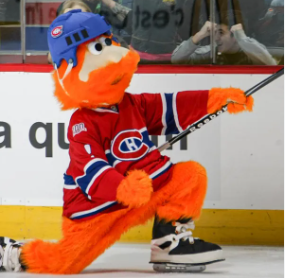
The Montreal Canadiens are one of the oldest and most successful professional ice hockey franchises in North America. Founded in 1909, the team is based in Montreal, Quebec, and is a founding member of the National Hockey League (NHL). Due to its wealth of success, the team has received an array of fan support, nicknames, and mascots, one of which is the beloved Youppi!
Youppi! is an orange, furry creature that serves as the official mascot of the team since 2005. Youppi! stands for “You Energize Our Proud People.” He is full of enthusiasm and always ready to meet the fans before, during, and after the games. It is no wonder why he is so beloved by the Montreal Canadiens fans.
Youppi! first made his debut during the Canadiens 2005 home opener in a 6-4 victory over the Florida Panthers. Since his debut, Youppi! has won over the hearts of the franchise’s supporters. He can be seen dancing on the ice during the player introductions and interacting with the crowd during intermissions and timeouts.
Youppi! has an official costume and can be seen wearing red and blue Montreal Canadiens apparel. Youppi! is most recognizable for his helmet, which has an orange “C” for “Canadiens” on the front. Youppi! is also equipped with a hockey stick which often carries a banner that reads “Go Canadiens Go”.
The enthusiastic mascot is known for playing fun games and activities with the fans during breaks in the action. Youppi! often hosts contests such as “name the mascot”, where the best nickname earns a prize.
If history is any indication, you can expect to see Youppi! supporting the Montreal Canadiens for a long time to come. He has come to represent the spirit and enthusiasm of Montreal hockey fans and the team itself. Whenever he is on the ice, the atmosphere is filled with joy, excitement, and the unabashed pride of cheering for the Montreal Canadiens.
The Nashville Predators Mascot

The Nashville Predators are an NHL hockey team that are based in Nashville, Tennessee, and the Predators mascot is an animated sabre-toothed tiger named Gnash. Gnash is a very unique figure in the sports mascot world. Not only is he incredibly dynamic and entertaining but he also serves to commemorate the city of Nashville’s past history.
Gnash was introduced as the official mascot of the Nashville Predators hockey team in 1998, the same year the team officially began play in the NHL expansion draft. While the team was originally named the Nashville Ice Tigers, they adopted the name “Predators” as a reflection of the Native Americans who once called the area home and also to emphasize their team colors of navy and gold. When it came time to pick a mascot to represent the team, Gnash was meant to symbolize not only Nashville’s prehistoric past, but also the strong and proud spirit of Tennessee.
Gnash is a bulky, animated sabre-toothed tiger that stands over 6 feet tall and weighs at least 250 pounds. His bright orange fur is highlighted by a navy and gold spine down the middle of his back and a large navy Predators logo on his chest. He usually wears long gold gloves, a navy and gold jersey, navy shorts, and sports big, round navy and gold shoes. He always has a large and friendly smile on his face and twinkling blue eyes.
Whenever the Predators have a game or an event, Gnash can be found entertaining fans of all ages. He loves to run up and down the aisles at Bridgestone Arena and show off his dance moves to entertain the crowd. He is always a great crowd pleaser and never fails to get the fans pumped up. He is also known to make appearances all around Nashville, visiting local schools and hospitals to spread cheer and meet the inhabitants of the city that he loves.
In addition to leading the Predators front office and personnel to Stanley Cup finals in 2017, Gnash also earned recognition from the NHL Mascot Hall of Fame in 2019. With his big personality, he has been an integral part of the team’s success both on and off the ice. As a result, he serves as a beloved symbol for not only for the Nashville Predators organization, but for the whole city of Nashville as well.
The New Jersey Devils Mascot
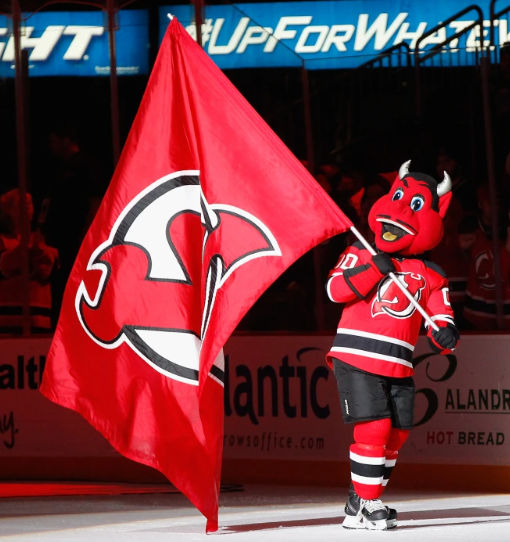
The New Jersey Devils mascot is a devilish figure known as NJ Devil. He was first introduced to the world in 1982 by the team’s then-owner, Dr. John J. McMullen. NJ Devil is an anthropomorphic creature of the type known as Devil Man, which combines physical features of a human with those of a devil. His body is covered in red fur, he has wings and a tail, and he stands at 8ft tall. He wears a black and red Devils jersey with the team’s logo. He has a pointed red goatee and large horns that top off his rather intimidating look.
NJ Devil is a hardworking, entertaining and enthusiastic mascot for the New Jersey Devils. He is often found entertaining the crowd at hockey games with his devilish antics. He has been known to break dance on the ice or even somersault in the air. He is an integral part of the Devils Experience, ensuring that all attendees of the Devils games leave with an unforgettable impression of the team and its mascot. NJ Devil is also active outside of the rink, making appearances at many different events, keeping the team’s spirit alive.
Though NJ Devil is often portrayed as a mischievous character, the overall message that he represents through his presence is positive. He reinforces the importance of teamwork, sportsmanship and dedication. By doing so, he continues to spread the enthusiasm and excitement that comes with being a New Jersey Devils fan.
NJ Devil has become a beloved icon of the team, as well as a recognizable symbol. He serves as an ambassador who embraces the past, present and future of the New Jersey Devils. He embodies loyalty and commitment to his team and its home state of New Jersey. He has become an iconic part of the team’s history and will no doubt continue to be for many more years to come.
New York Islanders Mascot

The New York Islanders is a professional ice hockey team that has proudly represented the state of New York since its founding in 1972. As one of the teams in the National Hockey League (NHL), there is no shortage of fanfare and spirit which is embodied by their team mascot– Sparky the Dragon.
Sparky the Dragon is an orange and blue Dactyl Dragon and has represented the New York Islanders for nearly thirty years. Sparky has been a source of enthusiasm for New York Islanders fans since joining the team in 1992. When the ice surface of the Islanders former home, the Nassau Veterans Memorial Coliseum, was cleaned at the start of the 3rd period, Sparky was a frequent main attraction. He would slide from one end of the rink to the other, showing an impressive show of athleticism. During the game’s intermission, Sparky interacted with fans, taking selfies and signing autographs. As the game went on, Sparky could also be often seen cheerleading and firing up the crowd.
Since making his debut in 1992, Sparky established himself as more than just a mascot. In 2007, he served as Grand Marshal of the St. Patrick’s Day Parade in Huntington, NY, proving that his reach went far beyond just being an on-ice character. In 2010, he was also an official athlete at the Empire State Games, where he proudly participated in the opening ceremonies as well as basketball and hockey competitions. Over the years, Sparky has gained even more attention due to his involvement in a variety of charity events. Most notably, Sparky has worked with the Islanders’ “Hope for the Holidays” program, a charity organization that raises money to help less fortunate members of the community.
Today, Sparky still serves as the official mascot of the New York Islanders. Fans can regularly find him at games, rallies, and other Island events throughout the year. Beyond that, Sparky is also involved in countless charity events throughout the surrounding Nassau county communities, making him one of the best-loved mascots in all of professional sports! So when you hear the roar of the crowd and bustling energy of the home crowd at an Islanders game, rest assured that Sparky the Dragon is a major part of it all!
The Ottawa Senators Mascot
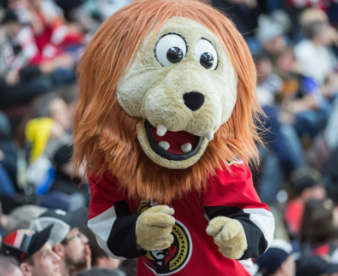
The Ottawa Senators, who play in the National Hockey League (NHL), created Spartacat in 2003. The club was originally founded as an expansion team in 1992, and the idea of a mascot coincided with the Senators as they set off on their journey to build a strong hockey team and culture in Ottawa. The name “Spartacat” is a nod to the famous film Spartacus and the Roman empire. The bright and colourful mascot is easily recognizable among all the teams in the NHL – he is the only furred lion and is the most unique-looking mascot of the 30 teams in the league.
Spartacat is beloved by thousands of Senators fans of all ages. As fans line up to get a wave and a hug from him, Spartacat also helps get the arena rocking before the Senators take the ice. Despite officially being an employee of Ottawa Senators Sports & Entertainment, Spartacat often takes on the role of the “12th man,” and the spark of energy he provides for the team is genuinely felt throughout the rink.
When he is not working at Senators home games, Spartacat can be found in the community, working with local charities, schools and even hospitals. His dynamism and enthusiasm never fails to bring comfort, joy and friendship to those who appreciate having him around. Every year, Spartacat can also be found at events such as the National Capital Vegan Festival, Canada Day celebrations and the Canada Aviation and Space Museum’s show.
It would not be incorrect to say that the loveable Spartacat is an essential part of the Senators hockey organization. Every Senators fan knows that you can never be too far away from the iconic Spartacat. Whether he’s visiting a classroom full of children or watching a game in the Senators’ arena, Spartacat is always there, bringing rich excitement and cheer to everyone he meets. That is certainly something that every Senators fan will attest to.
The Philadelphia Flyers Mascot
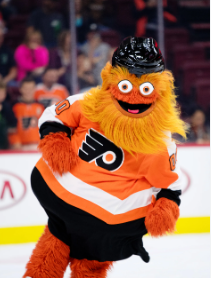
The Philadelphia Flyers mascot, Gritty, is a beloved hero in Philadelphia’s sports culture. The googly-eyed mascot was introduced to the public by the Flyers on September 24, 2018 during an exclusive press conference.
Since making his debut, Gritty has made waves throughout the sports world, becoming an international phenomena seemingly overnight. “Grit” has since been embraced by the Flyers fanbase and incorporated into the teams’ social media, marketing campaigns, and mascot merchandise.
Gritty’s story as the Flyers’ mascot is a unique one: he supposedly hibernated for decades beneath the Wells Fargo Center and awoke when demolition began for the new renovations of the arena. He is described in press releases as a “fun-loving, orange monster” with a burning passion for the Flyers and Phillies.
Gritty’s design is based on the traditional Flyers mascot, the Philadelphia Phantoms’ Slapshot, with a wilder, more action-oriented character than Philly Phanatic. He is composed of bright orange fur, a zany grin, and a disheveled, unkempt look – inspired by the “traditionally gritty” spirit of the city. It’s also said he has hidden holes in his body, likely used to store energy snacks and secret documents.
Since being introduced, Gritty has rapidly expanded his presence. He regularly takes part in community events, like visiting area hospitals, children’s charity initiatives, and parades. He also frequently engages with fans and observes Flyers’ games, often taking part in the “Let’s Go Flyers” chant that breaks out when the team scores.
Gritty was named the official NHL mascot in November 2018, and for the 2019 Stanley Cup Playoffs, was given the honor of raising the Flyers’ 2018-19 banner.
Gritty is just as popular as the team’s star players, and his presence on social media is one of the most active, colorful, and entertaining accounts on all of Twitter. Gritty has even spawned his own merchandise and other products, including bobbleheads, t-shirts, and hats.
Gritty’s presence at the Wells Fargo Center and his popularity around the sports world is unparalleled and continues to grow. He inspires an army of loyal fans who come tooting his name and fireworks. With his intimidating antics and ability to bring the fans to their feet, Gritty is a living embodiment of the spirit of the Philadelphia Flyers and their “Grit-itude.”
Pittsburgh Penguins Mascot

The Pittsburgh Penguins recently revealed their newest mascot, Penguins Iceburgh, and it’s quickly becoming a fan favorite. Iceburgh is a large, cuddly penguin who is dedicated to being a loyal mascot and ambassador to the Pittsburgh community.
Iceburgh has been around since 1992, when he was first introduced as a way to bring humor and fun to the game of hockey. He is a gentle giant with a large, booming voice, mischievous demeanor and an infectious laugh. His on-ice antics showcase his larger-than-life personality, which is sure to draw the attention of any crowd. Plus, his signature color is teal, which is the official color of the Penguins franchise.
The design of Iceburgh is meant to represent the strong bond between the Penguins and their hometown city of Pittsburgh. Designed by Ryan Callahan, Iceburgh was made to both fit in and stand out in the crowd. Through his unique style of dress and his personality, Iceburgh help break through traditional ideas of mascots and representation. His crystal-clear messenger eyes help show his focus on bringing people together and creating opportunities for everyone to come together, no matter the color or creed.
Iceburgh is very active in the Pittsburgh community, attending Kids of STEEL events and helping support the Penguins Foundation. He frequently visits local schools, hospitals and community events. He also played a part in the Penguins personal protective equipment drive, helping to provide medical staff with important resources.
The mission of Iceburgh is to bring joy and happiness to families, children and hockey fans in general. This mission is at the heart of the Penguins organization and is something that the team is truly proud of. No matter where Iceburgh goes, he always has a smile for everyone.
The Penguins recently hosted a contest for the fans to design their own Iceburgh plush toy and the winner was announced on their social media channels. This competition was an excellent way to get people involved and engage with the team and their mascot. Now, fans can have their own version of Iceburgh with them all season long.
The Pittsburgh Penguins are very proud to welcome Iceburgh to the team and hope that he’ll bring a lot of joy and spirit to the game of hockey.
Seattle Kraken Mascot
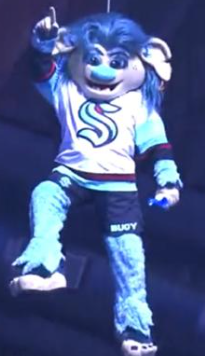
The Seattle Kraken are the newest NHL team and so their mascot does not have a lot of history. ‘Buoy” the troll is new but the mascot looks great with an aqua-blue nose and long blue-tinted hair.
Saint Louis Blues Mascot
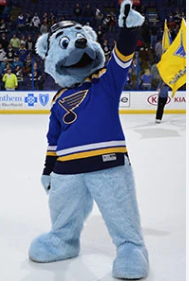
The Saint Louis Blues mascot, Louie the Bear, made his first official appearance during the 2018-2019 hockey season. Since then, he has become a beloved figure of the franchise and a beloved staple of the St. Louis sports world.
Louie is a fairly large, friendly looking bear with a custom Blues jersey with the number “L-B” on the back. His fur is a bright blue color and he also sports funky sunglasses and cozy sneakers to allow him to move around the ice with ease. He has become an endearing part of the team’s brand and is often seen sporting the Saint Louis Blues’ official logo on his chest.
Louie has been heralded for his good-natured behavior and huge personality. He loves to interact with fans, take pictures, and do short skits to engage the crowd. As a mascot Louie has attended numerous events ranging from hockey games to charity functions and has become a constant presence during home games in St. Louis.
The name “Louie” comes from the Saint Louis River which inspired the team’s moniker of the “Blues”. It also has relevance to music, as the “blues” is a popular style of music originating in the city of St. Louis. The bear’s number, “L-B” stands for “Louie from the Blues”.
Beyond his role as the official mascot of the Saint Louis Blues, Louie has also served as a symbol of good luck for the franchise. Fans are often seen holding up signs featuring him during the games and hoping for a win. According to legend, Louie the Bear is never present for a losing game and will always be seen sporting Blues jerseys during victories.
Overall, Louie the Bear is a representation of the franchise, the city of St. Louis, and its fans all rolled into one. He brings good vibes to all he interacts with and has become a beloved unofficial member of the Saint Louis hockey family. Louie the Bear is the heart and soul of the Saint Louis Blues and no game is complete without him.
The Tampa Bay Lightning Mascot

The Tampa Bay Lightning mascot, known as ThunderBug, is an integral part of the hockey team’s success. The mascot has been around since the team’s inaugural season in 1992 and is a beloved symbol of the Lightning’s fan base. As far as mascots go, ThunderBug is especially unique with its bright yellow fur and signature lightning bolt.
ThunderBug was initially created with a costume that was modeled off of the mascot of Tampa’s old Arena Football League team, the Storm. The costume was designed by the team’s original owners and was inspired by the Florida beaches. His look was modernized a few years after he was brought on board and has been constantly updated since then. ThunderBug is known for his energetic and entertaining spirit thanks to the series of stunts and activities he performs at the games.
ThunderBug’s signature move is the popular in-game skit, “High Voltage Thunder”. Throughout the game, the mascot electrifies the crowd with a creative show involving lightning bolts and smoke bombs. His enthusiasm and energy help to bring a more fun, lively atmosphere to the games.
ThunderBug often interacts with the team’s junior mascot, Bolt Buddy. Bolt Buddy is a youth version of the Lightning mascot and helps to bring even more fun and family-friendly elements to the games. In addition, ThunderBug can also be found at different events in Tampa and at Lightning hockey camps.
Being a mascot for a professional hockey team can be quite a demanding job. Mascots usually have to put in long hours and exert a lot of energy. The mascot job is even more difficult for ThunderBug since he is part of a demanding sports city like Tampa Bay. However, ThunderBug continues to be a dedicated athlete who faithfully entertains Lightning fans year after year. Through his vigorous activities, ThunderBug has gained lots of fans and will continue to be a symbol of the Lightning.
The Toronto Maple Leafs Mascot
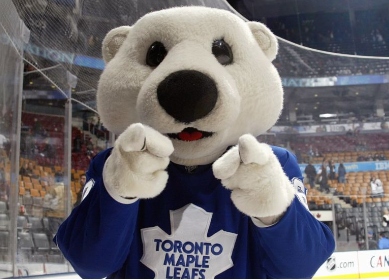
The Toronto Maple Leafs, one of the longest-running professional hockey teams in the National Hockey League, has been an iconic force in the Canadian sports scene since their founding in 1917. Since their beginnings, the Maple Leafs have consistently waved a proudly blue and white banner while representing the city of Toronto. Despite its robust history, one of the Maple Leafs’ most notable features is its mascot, Carlton The Bear. Carlton’s name and number (#60) comes from the location of Maple Leaf Gardens, 60 Carlton Street in Toronto, the Leafs home arena from 1931 to 1999.
Carlton The Bear is a unique mascot choice for the Maple Leafs, as most teams in the league either have mascots that represent dimensions of their team (such as the New York Islanders’ Sparky, who is a ‘spark of inspiration’ for their players) or characters straight from their team name (like the Carolina Hurricanes’ Stormy). This difference is part of what makes the fan experience for the Maple Leafs so special.
The origin of Carlton The Bear dates back to 2003, when the Maple Leafs first began searching for a mascot. After exploration of several traditional mascot designs, the Maple Leafs organization decided upon the design that best embodied their team’s culture and spirit — a giant, blue bear named Carlton. Meant to be a lively and friendly presence on the sidelines during Maple Leafs’ games, Carlton was designed to bring cheer and additional energy to the excitement of watching a Toronto Maple Leafs game.
In order to make Carlton the most recognizable Toronto Maple Leafs mascot, the design team looked to the city of Toronto’s very own Royal Canadian Mounted Police for inspiration. The decision to do this was to show respect and gratitude for the work that the RCMP does in protecting Canadians. Therefore, Carlton was dressed in a full Mountie outfit complete with a crisp red outfit and wide-brimmed hat.
But Carlton isn’t just a mascot – he is also a part of the Maple Leafs’ community outreach and charitable giving. Since his introduction, Carlton has been heavily involved with several charitable causes, including the Make-A-Wish charity, where he regularly meets and visits sick children in Toronto hospitals.
Carlton The Bear has become quite an icon in the Toronto Maple Leaves’ legendary legacy. With a unique mascot that represents the spirit and determination of both the team and their fans, the Maple Leafs have been able to create an experience that no other team can touch. Through his charitable and interactive character, Carlton The Bear has been able to capture the hearts of many Toronto Maple Leafs fans and is sure to have an enjoyable and rewarding career of entertaining and supporting all that enter the Air Canada Centre.
The Vancouver Canucks Mascot

The Vancouver Canucks mascot is the beloved Fin the Whale. He first appeared in 2001 and has been a fan favorite ever since. Fin’s full name is Finlay Salmon and he is a member of the Pacific Northwest’s indigenous Salish Sea Orca culture. As his name suggests, he is a killer whale, but with a few unique features. His blue and green fur, hat and sweater are true to traditional Pacific Northwest aboriginal attire, and his flippers have the numbers “94” painted on them to represent the young hockey team’s move to the newly built Canadian Sports Arena in 1994.
Fin is constantly attending Canucks home games and other events, including minor league and youth hockey games, Sharks games, and community events in the Lower Mainland. He is a true sport and loves to mingle with fans of all ages – always ready to pose for selfies and sign autographs. As a community ambassador, he represents the Canucks in the community, but he also acts as a “big brother” figure to the team’s younger fans.
Fin has added to the Vancouver community in other ways as well. He was an official ambassador for the 2010 Winter Olympics and was featured in the opening and closing ceremonies and supported many other Olympic events. He also makes appearances at local hospitals, schools, and charities and acts as a special “friend” of the Canucks organization. Fans can often spot his special “Fin the Whale” van driving around the city.
Since he was first introduced to the Canucks in 2001, Fin has become a beloved Vancouver icon. His likeness can be found on clothing and merchandise, and he appears in commercials and on video games to promote the team. But it’s his lively and enthusiastic presence that makes him so well-known and beloved by Canucks fans everywhere. With his unique look and over-the-top personality, he has quickly become the most recognizable and cheered mascot in the NHL.
Whether it’s after a goal or at a public event, Fin is always there to raise the energy and spirit of the crowd. He truly IS the life of the party, and a big part of why fans continue to show support for the Canucks. His lighthearted and lively presence at games and events is a constant reminder why the Canucks are beloved in the Pacific Northwest.
Vegas Golden Knights Mascot
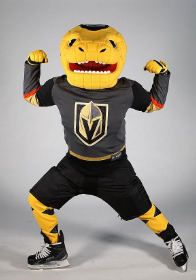
The Vegas Golden Knights of the National Hockey League (NHL) have risen to the top of the sports world in their short existence, and the franchise’s beloved mascot Chance is a big part of that success. Not only has Chance become one of the most recognizable figures in the league, but he was also the first professional mascot in Las Vegas’ history.
Chance got his start as the Golden Knight mascot back in January of 2018, when the team introduced him to the world during their home opener. Since then, Chance has been a lovable mascot for the Vegas Golden Knights, bringing energy and excitement to the rink at every game. When off the ice, Chance can be found interacting with fans, performing during halftime shows, and even participating in charity events.
Chance’s look is just as eye-catching as his antics. He’s donning a traditional golden suit adorned with chainmail, complete with a black and gold cape, covered boots, and a golden helmet with wings. Chance’s most famous feature, however, is his oversized foam head. It’s complete with a purple beard to match his bold and confident attitude.
When it comes to his demeanor, Chance is a gregarious and outgoing mascot with a positive attitude and plenty of energy. He engages with fans young and old, but always keeps his professionalism at the forefront. He’s full of big hugs and larger-than-life promotions, engaging in a variety of interactive activities throughout the games like pushing an inflatable goal in from of the net during penalty shots and scooping up popcorn during intermission.
Overall, Chance the Vegas Golden Knights mascot is a beloved figure for the team and an icon for NHL fans. He’s there to add energy and fun to any game and bring together the fan base. His unique stunts and personality make him stand out from the crowd, and he’s become a source of spirit and positivity for the team and the league. Chance is more than just a mascot; he’s a leader in the world of sports in Las Vegas.
The Washington Capitals Mascot
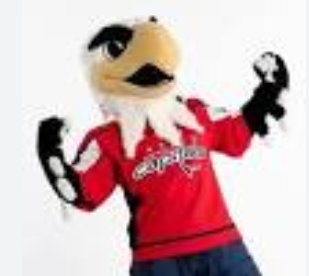
The Washington Capitals mascot is an eagle named Slapshot. Slapshot first joined the team as an unofficial mascot in 1995 during their first season at the then-MCI Center. Slapshot made his first official public appearance in 1996, during the team’s first playoff appearance.
Slapshot was originally designed using a drawing by Joseph Michael Krakora, the team’s first assistant coach, head scout and security guard. The design featured a large bird, with a full hockey equipment, a hockey stick and a hockey puck forming a large ‘W’ on its chest. Joe was a passionate fan and recognized the potential of an official mascot to connect the Capitals to their fans.
Slapshot is an energetic fan favorite and a great supporter of the team. He can often be seen on the sidelines during games, getting the crowd hyped up with a few crazy dance moves or performing stunts with his signature hockey stick or puck. He is often seen interacting with fans, doing fun activities to engage them and pump them up for the games. He also attends community events, school events, and charity programs.
Slapshot has a very professional attitude and a strict work ethic. At all of his appearances, he shows up completely in full hockey gear and goes about his job with professionalism and enthusiasm. From his intimidating presence on the sidelines to his friendly presence at community events, Slapshot has ensured that he is always remembered as the face of the Washington Capitals.
Slapshot is an integral part of the Capitals organization. He is seen as a team ambassador, always cheering on his team and promoting the organization in the community. His dedication to the team has earned him a great deal of love and respect in the Capitals organization, with the mascot even being referred to as the First Fan.
Slapshot is a beloved character, and his presence adds a unique flavor to the experience of being a Capitals fan. He is a great representation of all the team stands for, and he will continue to be a great source of fun and entertainment for the organization and its fans alike in the years to come.
Winnipeg Jets Mascot
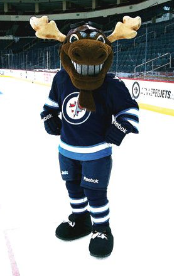
The Winnipeg Jets have had a number of different mascots over the years, but their current mascot is Mick E. Moose. For those unfamiliar with him, one look at Mick E. Moose will tell you all you need to know—he is the image of Winnipeg Jets’ spirit.
Mick E. Moose is a 5 foot 9 inch tall moose, wearing a blue Winnipeg Jets hockey sweater. With a white, smiling face, and a blue and white tuft on his “head”, Mick is quite the recognizable figure. The eyes and neck area are Velcro, allowing people to customize Mick’s look to match their favorite jersey. He loves to twirl, spin and dance all over the rinkside arena to get the crowd excited.
Mick E. Moose loves getting up close to the fans. He happily poses for photos, signs autographs, and takes time to answer questions.
Mick E. Moose deeply cares about the community and has gotten involved in a number of initiatives throughout the years. From visiting sick children in the hospital to helping to raise money for needy children in the area, Mick E. Moose loves to spread the spirit of giving and kindness with everyone he meets.
In addition to being an upstanding community-oriented role model, Mick E. Moose is also a huge fan of the Winnipeg Jets. He loves to watch the games and cheer the team on. Being the biggest Jets fan of all-time, it’s no surprise that he has become the official mascot of the team.
Not only did the incredibly talented Mick E. Moose represent the beloved Winnipeg Jets as their official mascot, he also made appearances in Thailand, Korea, and other places throughout the world. This helped introduce the Jets and their incredibly fun mascot to many different parts of the globe.
With his kind heart and larger-than-life enthusiasm, Mick E. Moose has become a fan-favorite for everyone associated with the Winnipeg Jets. Whether it is seen on a rink, at a game, or in the community, Mick E. Moose will continue to spread the joy and good will of Winnipeg’s beloved hockey team.
No matter which team you root for, there’s no denying the impact that mascots have on the experience of attending a professional hockey game. They put a smile on fans’ faces and provide a unique level of entertainment that further enhances the experience of watching a game.
Thanks for your time and please leave comments and suggestions below.

